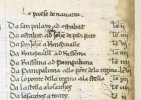This is actually a good point: a guarantee of convenience and security. Isn't it a bit of an illusion when we think of walking the Camino Francés as walking into the big unknown, where the universe unfolds as it should, where we don't know where we put our head tonight? We are walking in a populated cultural landscape, with lists of albergues, satellite-guided maps, instant online access to spot-on information and either the physical capabilities to walk on a few more kilometres or the security of a credit card or a handful of euros that will guarantee a bus trip or a taxi trip to our bed for the night.
I wholeheartedly agree.
An illusion it may be, but for many, many people it
is a great adventure in the sense that there are all kinds of risks, arrival is not guaranteed and unusual physical demands are placed upon us. For many Pilgrims, especially from the more developed world, it is a very different slice of life to the "normal".
I think most human minds do not enjoy the sensation of a "big unknown" and it is normal, maybe even instinctive, to attempt to put some kind of order on that unknown - hence the talk of "best this" and "best that", the reservations of beds and the like.
For each person what is "unknown" varies and can expand or shrink depending on mood or attitude.
On the other hand, entering the "unknown" can be an exciting, challenging and rewarding experience. The fears and anxieties we have at home are different in reality.
There are fewer, safer, better resourced places to challenge ourselves physically and emotionally and possibly spiritually than on one of the popular Camino routes.
Dare I suggest that if you were to walk out of your front door with no preparation at all, other than a determination to get from point a to point b on foot, you would eventually get to point b?
Hear hear!
There's only one problem with that;
A focus on the destination can distract from the journey to get there

Thankfully, there has always been a streak within humanity to venture into the great unknown. Sometimes that was fuelled by desire, sometimes by desperation, but since we no longer live in caves we know it exists.
For anyone approaching a Camino as a scary unknown, a great adventure, full of risk and struggle and challenge, they have a wonderful opportunity to succeed in a very safe environment.
I'm of the opinion that the "real" Camino comes afterwards. What do we do with the achievement, the success, the lessons learned? What exactly do we bring home from our Caminos? Has our attitude to the "great unknown" changed?
One thing I will say about SJPP is that I found a magical atmosphere there. I was absolutely charmed by the excitement in the air and sense of anticipation. Pretty much everyone else was "starting" there and I would have no hesitation in recommending it (or any other major starting point) for that factor alone. Nothing to do with history and everything to do with humanity. Sitting on a low wall and watching a trail of people tramp past me, hearing the conversations, watching the expressions and sensing all the different emotions in the air is a vivid memory.
Of course, it was all the more tangible for me since I arrived after a few weeks on the road.



















